Published: 4 December 2019
Share of persons with Finnish background in the birth rate has decreased
According to Statistics Finland, the share of women with Finnish background in the birth rate decreased to 86 per cent in 2018, when measured by total fertility rate. In 2018, the total fertility rate was 1.41 children per woman in the whole country, of which the share of persons with Finnish background was 1.20 children per woman. In 2010, the total fertility rate was 1.87 children per woman in the whole country, of which the share of women with Finnish background was 1.72. It corresponded to a share of 92 per cent of the total fertility rate in the whole country.
Total fertility rate broken down by mother's origin in 1990 to 2018
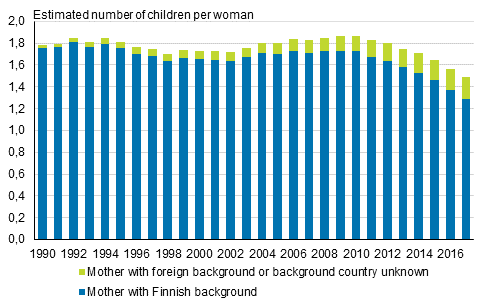
The birth rate is commonly measured with the total fertility rate, which indicates how many children a woman would give birth to during her life time if the birth rate remained the same as in the year on which the calculation is based.
The share of persons with foreign background in the birth rate in the whole country has slowly grown since the 1990s and is now 14 per cent of the birth rate in the whole country. In the corresponding time, the share of women with foreign background in all women aged 15 to 49 in the population has, however, grown slightly slower and is 10 per cent at the end of 2018.
Further information about the birth rate according to origin is available on Statistics Finland's Immigrants and integration thematic pages in the section Birth rate .
Birth rate also continues decreasing in all educational groups
The decline in the total fertility rate in the whole country which started after 2010, continued in all women’s educational groups also in 2018. The fertility rate of women with basic level education has gone down by 29 per cent and that of those with tertiary level education by 27 per cent from 2010. The fertility rate has diminished slightly less among those with upper secondary level education, by 25 per cent.
Total fertility rate of women born in Finland by level of education in 2006 to 2018
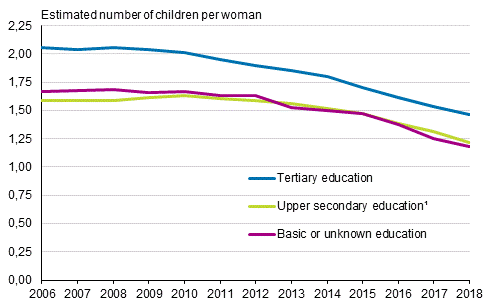
1. Includes post-secondary non-tertiary education.
The data here concern only mothers and fathers born in Finland. Some qualifications completed abroad are missing from Statistics Finland's Register of Completed Education and Degrees, for which reason the qualification data of many persons born abroad are deficient.
The fall in the total fertility rate has been similar for men to that for women. However, the change from 2010 has been steeper in all men’s educational groups.
Total fertility rate of men born in Finland by level of education in 2006 to 2018 ╣
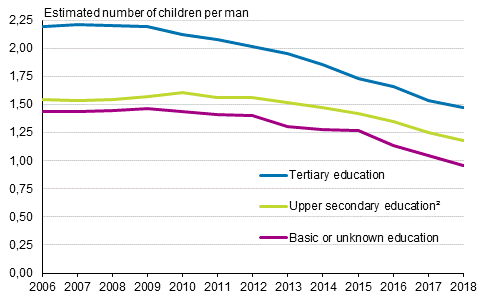
1) Information on fathers of children born outside marriage is obtained only when paternity is confirmed, and that is why it is received at a delay. For this reason, there may be slight deficiencies in the data for 2018 concerning fathers. For around one per cent of children, information on fathers is completely missing.
2. Includes post-secondary non-tertiary education.
For men with tertiary level education, the total fertility rate has decreased by 30 per cent and for those with basic level education by 33 per cent since 2010. The fertility rate has diminished slightly less among those with upper secondary level education, by 27 per cent.
For men the mutual differences of educational groups in the levels of fertility are bigger than for women: for men the fertility rate of those with basic level education is clearly lower than in other groups. The total fertility rate of men with tertiary level education has been slightly higher than among women of the same educational group, but the figure for men has decreased faster and now they are at the same level.
Birth rate has diminished by one fourth in eight years
The birth rate has declined considerably from 2010 to 2018. Measured by the total fertility rate, it has diminished in eight years by 25 per cent, from 1.87 children per woman to 1.41 children per woman. In one year, the decrease grew by five percentage points, since from 2010 to 2017 the total fertility rate decreased by 20 per cent. The total fertility rate can be broken down by the order number of the child born.
Total fertility rate broken down by birth order of child 1990–2018
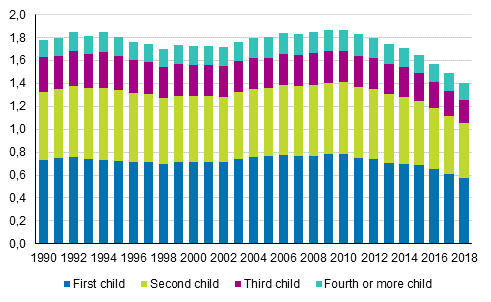
The decrease in total fertility was divided by the number of children so, that the relative change in the number of children did not grow the lower the order number of the child was. For the first child, the change from 0.78 to 0.58 children per women from 2010 to 2018 means a reduction of 26 per cent, for the second child 24 per cent and for the third child 28 per cent. Correspondingly, for the fourth and higher order number child the change was 17 per cent.
Regions of Ostrobothnia still differ most from the birth rate in the whole country
Even though there are differences between regions when it comes to the level of births, the development of the birth rate has been similar in all regions over the past years. While the total fertility rates of the regions of Ostrobothnia varied from 1.64 to 1.92 children per woman in 2018, the figures for all other regions of Mainland Finland correspondingly fluctuated close to the figure for the whole country, 1.41. The figures for these other regions varied from 1.32 to 1.47. The total fertility rate in ┼land was on the same level as that of the regions of Ostrobothnia, 1.64.
Total fertility rate in the regions of Ostrobothnia and the whole country in 2000 to 2018
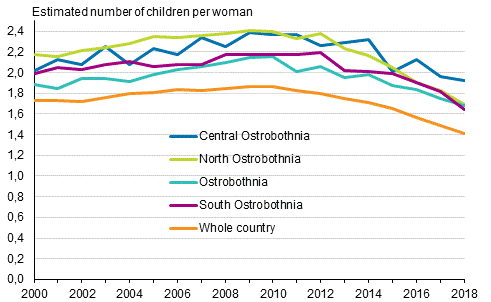
Despite the decrease in the birth rate, the total fertility rates of the regions of Ostrobothnia and ┼land are 16 to 36 per cent higher than the figure for the whole country in 2018. On the other hand, the figures for the other regions were, at their highest, either six per cent lower or four per cent higher than the figure for the whole country.
Total fertility rate by region in 2018
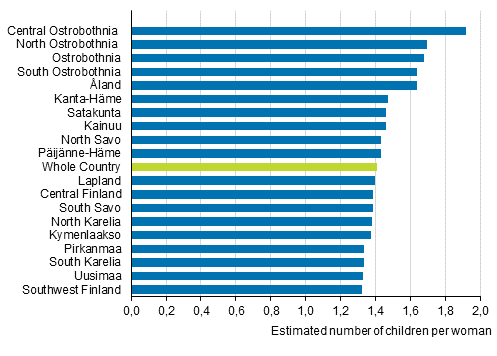
The birth rate of Swedish-speaking persons still higher than that of Finnish-speaking persons
Since 2006, the birth rate of Swedish-speaking persons has been slightly higher than that of Finnish-speaking persons. Even though the birth rate has declined in both groups in recent years, it has declined less among Swedish-speaking persons. In 2018, the total fertility rate for Swedish-speaking women was 1.57 children, while it was 1.35 children per Finnish-speaking woman. In 2010, the total fertility rate for Swedish-speaking persons was 1.95 and for Finnish-speaking persons 1.85.
Total fertility rate of FInnish-speaking and Swedish-speaking women in 1991 to 2018
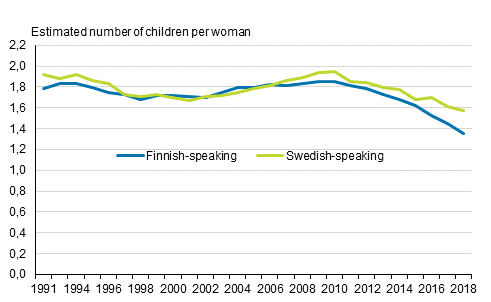
Swedish-speaking women have been slightly older in average age when giving birth than Finnish-speaking women at least from 1991 to 2016. In 2017 and 2018, the average age of Finnish-speaking and Swedish-speaking women becoming mothers was the same, 31.1 years. The Swedish-speaking women becoming a mother for the first time have also been slightly older in average age than the Finnish-speaking women, but the difference has narrowed. In 2018, there no longer was a difference and women from both language groups were, on average, 29.4 years when they became mothers for the first time.
Source: Births 2018. Statistics Finland
Inquiries: Timo Nikander 029 551 3250, info@stat.fi
Director in charge: Jari Tarkoma
Publication in pdf-format (302.0 kB)
- Tables
-
Tables in databases
Pick the data you need into tables, view the data as graphs, or download the data for your use.
Appendix tables
- Quality descriptions
-
- Quality description, births 2018 (4.12.2019)
Updated 04.12.2019
Official Statistics of Finland (OSF):
Births [e-publication].
ISSN=1798-2413. 02 2018. Helsinki: Statistics Finland [referred: 18.12.2025].
Access method: http://stat.fi/til/synt/2018/02/synt_2018_02_2019-12-04_tie_001_en.html

